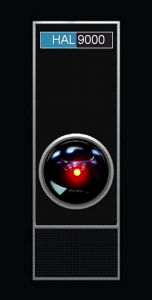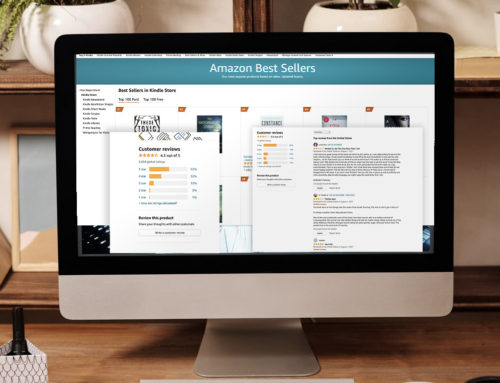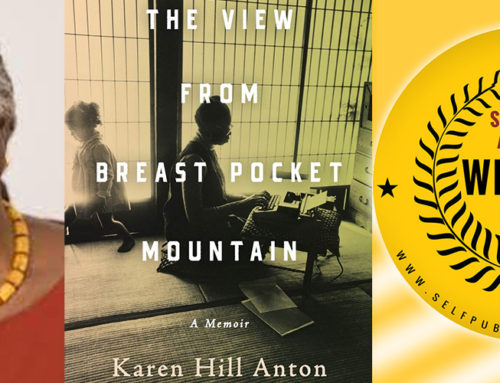There are some home truths we need to examine that authors are not really grasping about the Amazon Algorithm since I started this series. So in this installment of “Mythbusting,” I’m going to get into what the algorithm’s new Machine Learning model and new Amazon Guidelines mean for Verified Customer Reviews.
MYTH 1 – By figuring out what keywords people search for you can get customers to find your book
 TRUTH – Meh. Here we go again. My answer to this is “Are you a robot?” You would have to be Hal 9000 since the new algorithm came along. Let’s strip back to the definition of an algorithm. It’s a series of instructions that find patterns in data, based on a series of questions asked about the data needed to sort it. At Amazon, the algorithm sorts data into a list, much like the Google Page Rank algorithm, a set of instructions that sorts search results by popularity.
TRUTH – Meh. Here we go again. My answer to this is “Are you a robot?” You would have to be Hal 9000 since the new algorithm came along. Let’s strip back to the definition of an algorithm. It’s a series of instructions that find patterns in data, based on a series of questions asked about the data needed to sort it. At Amazon, the algorithm sorts data into a list, much like the Google Page Rank algorithm, a set of instructions that sorts search results by popularity.
Google Page Rank was the first algorithm to sort by popularity in this way in a search engine, and that’s why we use it more than any other search engine nowadays. Amazon takes that idea and asks even more questions based on even more data to serve its shoppers. But there are major differences in the reason Amazon wants to answer these questions – it’s not interested in telling you what’s most popular, but what’s best for you personally to buy.
So Amazon’s algorithm is based on a huge amount of personalized data that gives it answers to sort by in real time. This data is often referred to as many algorithms, but really it’s all part of the same data sorted differently according to the questions asked for each sort. This data is? Every single Amazon customer’s behavior, i.e. search, browse, and purchase along with Verified Reviews count towards the visibility in search results, and how books ranks. That’s at least 304 million people’s preferences influencing your book (stats from Statista), with around 63 million of those customers being Prime users.
You can figure out what keywords might be popular in your category IF you could look at the method used by the algorithm to sort by keywords, which you can’t. You can take some educated guesses by figuring out what keywords the top books in your category are using for short term promos by utilizing tools such as KDP Rocket or Kindle Samurai. Even Amazon give advice that you should try and figure out some keywords by having a browse and asking your friends what to use, but really this is a shot in the dark.
The million-dollar question (scrap that, multi-billion-dollar question) as to what the algorithm uses to figure it out? Probably only the algorithm knows, because there are literally too many variables in real time. But the data you don’t have is all that customer behavior per customer. Here’s what A9, the creator of the algorithm, has to say about how it works:
“We index millions of documents worldwide, and deploy them on highly scalable massive fleets of servers. We reflect millions of price and inventory changes in real time, and we return relevant results in milliseconds.” So you think you can beat that, huh? Just with your brain and a few typed-in words? Are you a robot?
In other words, you would need to know which words were typed into Amazon’s search bar that led from the search to the sale the most times, because these words will be the ones that the algorithm understands are the most profitable. The Amazon algorithm changes its parameters in real time as it learns about each customer’s new behavior each session so that it can serve the most likely and the most sellable products to that customer. So if you do research keywords, do it very often.
Can you privately test out keywords by not logging in or using a VPN?
Guessing keywords, as I said before in another installment, will lead to you achieving one thing: teaching Amazon you search for those keywords in your account. Even logged out, factors like IP address, geolocation, and how you have used social media in that same session online will feed into that information just for you, and therefore your demographic. Because Amazon also tracks what people it thinks are similar to you buy, you can’t even know what info is being fed into a personal profile.
So any talk of cloaking your identity to search in Amazon to get a “clean” result is next to useless.
In a nutshell, there’s not a reliable way of researching keywords without muddying the waters you are hoping to swim. We can conclude that what is happening is hard for some authors to swallow, as myths abound on just about every forum about keywords, but unfortunately keywords, although important to general visibility, cannot be “hacked” to give you overreaching success with sales.
Keywords just don’t work the same on Amazon as they do on Google, because Amazon is self-serving, using data to covert sales, while Google is ubiquitous. See my previous parts of Mythbusting to get into that, as well as the keywords you have to use with certain categories. Yes, there are specific keywords, all laid out for you. I link to it in the previous article.
Adding keywords to URLs
I would also like to point out that there has been some research into adding keywords to URLs discussed on forums. There really is no value in this for a basic reason – if you give out that URL time and again, the likelihood that link is clicked and abandoned is high, let’s be honest. Not everyone you give the link to will click and buy. So let’s say you get 100 people to click on that link. Let’s say you get 30 sales, and 70 people abandon the link. This tells Amazon there’s a 70% chance that these keywords do not sell your book. So you may, based on the 30 sales, rank highly for a day or so in your category, but it doesn’t mean you have achieved anything long-term. Why?
Apart from the obvious that I just pointed out that you just told Amazon the 70% chance of not making a sale on those keywords? OK. Because, what are your keywords? Without knowing what keywords people are searching for, which I think I have established is nigh-on impossible, how can you know if it’s had any effect on your ranking whatsoever? Sure, if you type in “swords and sorcery in Germany” and you just sold 30 copies, you as the author, i.e. most likely to be the most interested client on Amazon as far as the algorithm knows, you’ll see it as a top listing if you type in those words. But once another book sells 50, you won’t be there anymore and that link you sent out all over the shop? Useless. Because now those keywords are ranking high for someone else. And not only that, you’ve just educated Google in those keywords, so that book page link? Probably shows up a lot lower now the other person’s more successful book is riding on your wave.
By the way, when I worked in SEO for corporations, we used this trick to push down negative news articles that needed to get lost on Google. Reverse marketing. So, not a good plan.
Using URL + keywords to track a campaign
You can test the success of your email or ad campaigns and see how many people bought your book from that exact URL by tracking it from an email with Google Analytics. I won’t reinvent the wheel, so here’s how to do it on GA’s website.
MYTH 2 – Amazon is unfair and has a bias in the way it shares indie books on its site
TRUTH – Amazon is a buyers’ site. So, yeah. Amazon wants to highlight products most likely to be bought by each individual customer who is browsing. Remember this, and you’ll start to find ways to make your book more attractive within Amazon’s shop to make them more likely to be preferred by the sort of buyers that like your type of book. Amazon expects products to meet a minimum standard and allows customers to report quality issues on product pages. When you sell on Amazon you sign an agreement to sell on Amazon according to their company policies. They will announce updates to policies, but basically they are going to do what’s best for Amazon. I don’t understand the outrage on this. Amazon gives you a chance to publish your book in a way no publisher lets you, and even promotes for you for 3 months. For free, maybe at a loss. And you’re complaining? Come on.
If Amazon’s algorithm is learning a unique profile for each user that is literally not known manually to any human being on Earth, then it’s impossible for Amazon to do much at all against indie authors in particular. This is called “machine learning.” In other words, the “machine” stores millions of answers to questions asked, i.e. likes, dislikes, types of product, age of purchase, and can “learn” on average what each customer prefers to buy. This is called a “machine learned model.” Since 2016, the algorithm has been using its own learnings to suggest products to users, as reported by CNET from Amazon here.
By not following Amazon advice and help on how to improve product visibility and ranking, it’s nigh impossible to just get books sold by popping it up on KDP without any marketing. I’m amazed by how many authors still talk to me about expecting to make over $10,000 on their ebook but have absolutely no plan nor budget for marketing.
Simply, nobody can sell a book without marketing it. Otherwise Stephen King and JK Rowling would not spend thousands of dollars on promotion each and every time they release a new tome.
MYTH 3 – Customer Reviews don’t improve my chances of being seen on Amazon
TRUTH – They do because they help you get seen by your potential readers in particular.
Verified Reviews uniquely count towards ranking and help with exposure to your potential readers in particular. This is because if the sale is recorded in a customer’s account and then the product is reviewed by the customer, this rating feeds into both the customer’s personalization data and also the overall data for that product into the algorithm in a way unverified reviews do not. This informs that particular customer’s likes and dislikes, i.e. book genres, types of authors, which sorts of books they have reviewed positively, and which books they have bought after searching for certain keywords associated with books like yours. It also may feed into data for customers with similar buying profiles, which is key. The algorithm tracks the patterns made “in aggregate,” simply put, people who are the same age and have the same lifestyle, similar income etc. as you probably behave like you on Amazon, because people are known to make consumer buying decisions “in aggregate.” So reviews from people like you will also count towards what you see in your Amazon lists, because it’s an educated guess you like and want the same products. You can read about this on Wikipedia for a quick skinny.
Because of this, Amazon sees Verified Reviews as valuable “sorting” data for sharing products that are relevant and of good standing with the customers who will be most likely to purchase those products. This means it’s in your best interest to get Verified Customer Reviews in order to serve your book to the most likely-to-purchase Amazon customers.
So the truth is, if you have been sweating it over keywords, your time is better spent having a great book with many positive ratings, purchased and reviewed regularly.
“Amazon calculates a product’s star ratings using a machine learned model instead of a raw data average. The machine learned model takes into account factors including: the age of a review, helpfulness votes by customers and whether the reviews are from verified purchases.” Amazon says.
In fact, given the way the algorithm works with searching products, one of the ONLY ways you can let it know your product is good is via Verified Customer Reviews.
MYTH 4 – I can get Verified Customer Reviews by using KDP promotion-reduced, gifted, swapped, or free pricing to boost my ranking.
TRUTH – Verified Reviews are not going to show up, even when books are downloaded from Amazon directly, when provided for an “incentive”. I asked Amazon, because this was a point I was seeing as very confusing to authors, and it seemed unclear and contradictory at times. This was the answer I got via KDP Support:
“When a Customer Review is marked “Amazon Verified Purchase,” it means that the customer who wrote the review purchased the item at Amazon and did not receive the item for free or at a large discount.
Reviews that are not marked “Amazon Verified Purchase” are valuable as well, but we can’t confirm that the product was purchased at Amazon or that the customer paid a price available to most Amazon shoppers.
Moreover, the order must be complete (marked as delivered), you order or download the item on your account that you have used in reviewing the item on the website, no promotion applied and the review is posted after you received or download the item for the “Amazon Verified Purchase” will automatically appears on your review.”
Furthermore, the guidelines state:
“We will continue to allow the age-old practice of providing advance review copies of books. ”
This seems at first glance rather in direct contradiction of their statement,
“Our community guidelines have always prohibited compensation for reviews, with an exception – reviewers could post a review in exchange for a free or discounted product as long as they disclosed that fact. These so-called ‘incentivized reviews’ make up only a tiny fraction of the tens of millions of reviews on Amazon, and when done carefully, they can be helpful to customers by providing a foundation of reviews for new or less well-known products…
Today, we updated the community guidelines to prohibit incentivized reviews unless they are facilitated through the Amazon Vine program.”
A bit of sleuthing led to a copy of the email you would receive if you have incentivized reviews on your book.
We recently updated our policies to prohibit incentivized reviews, including those posted in exchange for a free or discounted copy of the product. You are receiving this email because products you sell have received incentivized reviews in the past. If you attempt to acquire incentivized reviews going forward, your Amazon privileges will be suspended or terminated.
We consider a review to be incentivized if you have influenced or can influence the review directly or indirectly, including by monitoring whether a review is written and providing or withholding any future benefit based on whether a review is written or the content of the review. Below are a few examples where a review is considered incentivized and is not permitted:
- You provide a free or discounted product, gift card, rebate, cash payment, or other compensation in exchange for the review.
- You provide or withhold free or discounted products or other benefits in the future based on whether the customer writes a review.
- You use a review service where reviewers’ continued membership depends on writing reviews.
- You use a review service where you can rate customers based on their reviews.
- You use a review service where customers register their Amazon public profile so that you can monitor their reviews of your products.
Incentivizing customer reviews violates our policies and may violate the Federal Trade Commission Act.
The following actions are generally allowed, provided you comply with the above restrictions:
- You may offer discounts that are generally available to all Amazon customers, such as Lightning Deals
-
You may give out free products at trade shows, conventions, or other similar venues where you are unable to monitor whether the recipients write a review or provide or withhold any benefits based on whether a review is written or the content of the review.
So from now on, reviewers should never add “I received this book for a review” because it will be deleted and could literally be ILLEGAL!
Using promotion services such as BookBub, and our services at SPR where reviews are sought via book promotion is OK because we are not employing reviewers to definitely review. We have lists of readers who get the promotions through and choose to review. This is the difference – and the bottom line is that reviews MUST be unbiased and honest. The only way to do that is to not expect a review when a purchase is made. So how to get reviews? You have to market to hundreds of readers to get a few reviews.
MYTH 6 – As long as I get reviewers to buy the book it will count as “read”
TRUTH – Nope. Amazon serves a review request and similar books to yours at the end of a read. If a buyer then buys another book from that link, you will be featured in the list “Customers Who Bought This Also Bought…” Also, Amazon knows how many pages a reader finishes. Using this information for their algorithm shows Amazon which books are enjoyed and read for real, therefore which books are quality products. So if you ask people to read your book for a review, they’d better be actually reading it.
MYTH 7 – Getting into a niche category’s Top #100 is a waste of time because nobody will see my book
TRUTH- Wrong again. A cent for every time I hear this… Authors who actively choose relevant bestseller categories will sell more books, period.
Dumping your book in “Mystery” or “Romance” will get you nothing. There are thousands upon thousands of books in these “parent” categories, and yours will be another needle in a very large haystack.
However, if you were to choose a lesser populated category, i.e. “Mystery – Hard-boiled” or “Romance – Victorian,” i.e. a “child” category, and then add some keywords, “noir” and “Australian” for example, you narrow down your field to maybe a few hundred books in that haystack.
Here’s the thing: Get into any Top #100 BestSeller List category and you will be automatically promoted and featured more by Amazon’s algorithm more than you would have been if you are #250000 in any parent category, plus you can start showing up higher in the parent category of that child category. That’s how you climb that ranking, baby! There are almost 19,700 categories to choose from, so don’t go telling me you can’t find one. Not only that, Amazon adds around 300 new ones a month.
TIP, don’t forget you will need to assess and change your categories periodically as new books come in a sell huge amounts. Your category just got swamped by a novel about Queen Victoria’s (fictional of course for those history buffs) dark romance in Australia? Fine, seize an angle, change categories, and ride the wave by promoting again for a few sales and reviews.
MYTH 8 – It doesn’t matter how many reviews I have, it won’t make a difference to my book sales
TRUTH – I’m seriously fighting this one again? Jeez. Amazon’s algorithm judges your popularity and therefore your book’s quality as a product to promote by two main things: sales and reviews. That’s it.
All past sales inform the personalization info for each customer, so the more books that you sell the more likely your book will be suggested to that customer if it is similar to books they like to read. The more positive reviews you have, verified reviews that is, the more info Amazon has on readers who liked this book after purchasing it on Amazon.
That’s why it matters that they are verified reviews.
Getting verified reviews is therefore of utmost importance in the early days of promotion. It’s the only way to get any peer approval and ongoing visibility.
MYTH 9 – Selling books by running a promotion is a fake way to get more sales
TRUTH – It might be the only way you get sales in the first place. Marketing is as old as the hills, from giving out free samples to asking celebrities to endorse, the only proven way of selling something is show that other people are already doing it and liking it.
There’s no shame in paying for promotion if it means the public buys your book, and marketing for a booster of sales will lead to reviews and more sales as others – and Amazon’s parameters – pick up on the buzz around your book. Don’t be a martyr. Get marketing.
Further Findings/Conclusion – Verified Reviews with Amazon
- If you do give out ARCs for review, you cannot be seen to assume a review is forthcoming by offering the book for the purpose of garnering a review. It’s going to be really important that ARCs are not sent as a product from Amazon, but given outside of Amazon via email in PDF form, or in person as a manuscript. But this poses a bigger problem – the reviews you get from ARCs will NOT be verified, because a purchase will not have been made. So you need to hope the reviewer who read your ARC buys the book after leaving their review. But you wouldn’t be able to request this purchase.
- Furthermore, it seems that you should leave out the wording, “I was given this book in exchange for a review,” as this means it is an “incentivized” review. Amazon do not accept reviews that have been garnered by giving out books for reviews. Amazon doesn’t care how the book reached the reader unless it’s been bought on Amazon, so justifying it doesn’t help you, and can damage you, and could be illegal.
- Gifted books do count as a transaction, so will be Verified if the gift code is used in the account that the review is posted. However, if Amazon reviews this review, they will most likely delete the review, and maybe the reviewer’s account, because it is incentivized from the author’s account, i.e. the gift came from the product owner – some authors have claimed that their gifted book can’t even be reviewed if they gifted it from their account. Also, worth noting that if a book is gifted and the recipient converts this to a money credit, any review they leave as Non-Verified afterwards would be seen as a “Paid Review” and deleted. So it’s not advisable to gift books in order to garner Verified Reviews in any case, especially not from the same account you use for your book admin.
- KU Borrow reviews do not count as Verified Reviews. Again, you have to hope they buy the book instead of using their KU account. More depressing news for indie authors.
- Remember any of these types of reviews that resulted without an Amazon purchase will be non-Verified until they buy the book. This will not automatically convert the review to Verified. To convert the review they will have to edit the review in order for it to trigger the system into knowing it’s now a Verified Review. This is NOT updated automatically, and all activity, i.e. the borrow, the review, the purchase, and the updates will have to be made on the same Amazon account.
- Purchased books lose their Verified status if the book is returned.
- If authors swap purchases and this is tracked by Amazon, both reviews will be deleted, and could result in your Amazon account being deleted.
So if you really want to get Verified Reviews, it’s going to have to be through genuine reader lists such as BookBub and SPR, and pure slog at marketing.
Basically, these days to sell books, you need to sell books.
You can read Part I and II of this series here.
Get an Editorial Review | Get Amazon Sales & Reviews | Get Edited | Publish Your Book | Enter the SPR Book Awards | Other Marketing Services






















I’m clearly not suited for marketing. All that marvelously detailed advice, while it may help others, doesn’t interest me. For me, it’s a needless complication.
When I write, I do my best to say what needs saying and do so as interestingly and effectively as I can. When I come up with the title, I try to make it pithy and interesting. When I decide on the subtitle, I intend it to describe, in as few words as possible, what the book is about. My latest, Embarrass Less, was written for healthcare workers and students, so the subtitle is “A Practical Guide for Doctors, Nurses, Students and Hospitals.” I don’t make an effort to make it appear otherwise to increase sales, other than by suggesting to the general public that, if they fret about being embarrassed during their hospital stay, they might give a copy to their nurses.
The cover is my best effort to describe a book visually with as much creativity as I can muster. Embarrass Less, for instance, has a picture of the only patients in hospitals who aren’t embarrassed, two cute kids playing doctor. Ditto for the book’s description, its BISAC classification, and those keywords. I do my best to let the public know what they’ll get if they buy. I let my reviews fall where they may. Why worry about what I cannot change?
Doing that spares me from dealing with the mechanics of driving my book to the top of Google or Amazon search results. To the extent that those search engines are intended to assist the public, my efforts to do the same will work. To the extent that they’re driven by other factors, it’s pointless to try and beat a system I can’t control and that constantly changes.
Indeed, what I’m trying to do, attract people who’ll enjoy my books, and what search engines should be trying to do, push people to books they’ll buy, are much the same. If I were to try tricks posted online to raise my search ranking, it’s likely that Amazon would spot that and come up with a way to prevent it from working. I might end up with a lower search ranking. And no, I’m not going to fall into the trap of paying Amazon to promote my book. That’s a dangerous policy to encourage.
In short, if you like the mechanics of marketing, then by all means use them. They probably will increase your sales. But if you don’t, then relax. Honesty is the best policy. Focus on what you like best, which is probably the writing, and leave the promoting to your happy readers.
One additional remark. Many of these discussions revolve around authors coming up with ways to attract book reviews. Perhaps the best approach is to encourage an ethos among authors. If you read and enjoy a book, as a courtesy to its author, give it reviews and perhaps even promote it. Do that especially if he’s a stranger rather than your bosum buddy since the third grade. That’ll get around the controls that Amazon places on reviews.
–Michael W. Perry
Excellent article! But now with Amazon’s new rules around incentivized reviews, I am questioning the value of making a book available on NetGalley to gather ARC reviews. Any thoughts on whether this is still a good practice and what the best approach is to avoid running into the review police?
To be honest I have found NetGalley a strange system from the start. I don’t think there is much value in it as a self-published writer, based on the fact I don’t like anything that costs a lot of money and takes so much effort without any guarantees, and worse, you could end up with a ton of negative reviews – this seems to be a “thing” with NetGalley readers. Given also the new rules could mean you are seen to be getting incentivized reviews, I wouldn’t do it.
Ha, send me your caveats I’m all ears! Thanks Dave!
With regards to Myth 4, I thought that book reviews were the exception here. Did that just change?
You can ask someone to review an ARC but not to review your book as a product. See my Further Findings for clarification, last point.
It seems more likely that the below is true::
[Quote]bloggers and Amazon.com
reviewers now must disclose freebies and financial interests or face
fines up to $11,000, according to rules announced by federal regulators
Monday in an attempt to make word-of-mouth endorsements on the net
easier to believe.[/Quote]
:: So Amazon can only consider it illegal if the person doesn’t include those words you have so clearly just told your readers not to include.
Amazon has every right to remove something that doesn’t declare this when they find that it is in fact the case and they are liable if they don’t. However it is not illegal if the reviewer declares it so their choosing to remove it become somewhat egregious and would be in fact their choice and not a compliance to the FTC rules.
J.L. Dobias
It seems that should be the case, but you should not be giving books out for the sole purpose of gaining a review in the first place. This is key. I say above, that to declare, “I was given this book in exchange for a review,” as this means it is an “incentivized” review.” Amazon do not accept reviews that have been garnered by giving out books for reviews.” The only time a reviewer should declare they were given a free copy is in the case of an ARC, but as I say, “If you do give out ARCs for review, you cannot be seen to assume a review is forthcoming by offering the book for the purpose of garnering a review.” So the wording should not mention “in exchange for a review.” Instead, to say only, “I was given an ARC by the author” leaving out “in exchange…” seems to be wiser. This covers all bases.
[…] Mythbusting 3 – Verified Review and Guidelines […]
[…] 1 | Mythbusting 2 | Mythbusting 3 |Mythbusting 4| Mythbusting […]